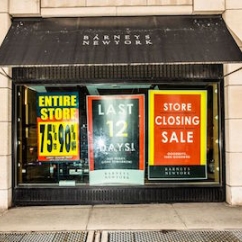Articles and News
Editorial: Hey! Over Here! | May 20, 2020 (0 comments)

Merrick, NY—What do Neiman Marcus, Bergdorf Goodman, and Barneys New York have in common? (Left: Barneys New York during liquidation. Image, The Cut.)
All three are (or in the case of Barneys, were) known for sophisticated, well-curated fine jewelry departments, highly sought after by aspiring luxury jewelry brands. Even if a brand never made much money selling there—generally those partnerships are all consignment—the cachet of being able to say they’re sold in Barneys, Bergdorfs, or Neimans was well worth it as an investment in future success.
All three also are in big trouble. Barneys has already shuttered, while Neiman Marcus and Bergdorf Goodman (same company) recently filed for bankruptcy. While the coronavirus pandemic may have hastened the downfall of some department stores (Lord & Taylor) and put otherwise healthy ones to a rigorous test (Nordstrom), it wasn’t the cause of Barneys’ or Neimans’ problems. But what do their problems mean for the small unique luxury brands that were the mainstay of such stores—and for whom such stores were the mainstay of distribution?
In an article in Glossy, renowned jewelry designer Fernando Jorge points out the importance of those retailers as a launching pad. When he first launched his collection in 2013, says the article, he had no business plan, marketing, or storytelling ideas—but he did have a partnership with Barneys New York. That propelled him from being just another talented would-be to award-winning international brand.
But without those outlets, how will luxury jewelry brands like Jorge and other luxury goods find their way from designer to customer?
Two key emerging routes are online and direct sales, says Glossy. Jorge, for instance, is now 70% wholesale (mainly through luxury e-commerce sites like Moda Operandi and Net-A-Porter) and 30% direct to consumer. There was no mention of wholesale through independent retailers.
What gives? Why are these designers ignoring the vast network of well-connected local jewelers (or other retailers) who have a solid base of luxury customers they know as friends and collectors, and to whom they can recommend a new designer whose aesthetic matches the customer’s taste?
This isn’t a new phenomenon. Ever since my early years in the industry, when I was fashion editor at JCK, I’ve wondered why fashion magazines seem to love jewelry from designers outside the mainstream industry. Flip through any fashion tome, whether upscale like Vogue or Harpers Bazaar or more accessible like InStyle. The jewelry shown usually comes from traditional luxury houses like Cartier and Bvlgari, big brands like Le Vian and Effy that advertise heavily, or from independent designers that operate in a whole separate world from the rest of the industry. Occasionally you’ll see some of the brands you know from trade shows, but they seem to be the exception, not the rule.
This has puzzled me for years, as I’m sure it’s puzzled many of you. I’ve asked why, and gotten some answers: jewelers all want memo or terms; tradeshows are expensive with no guarantee of getting exposure; it’s easier to make pieces as needed than finance a line, and so on.
Some of these issues are certainly within the industry’s control. Jewelers can support young designers by buying outright rather than going on consignment, or if they’re not ready to do that, perhaps invite a new designer in for a special event trunk show to test how well they might do as a regular offering. JBT tracks which retailers pay on time. And the major trade shows do, by and large, offer some options for new designers to participate for a reduced rate, but perhaps there’s more that can be done in that regard.
Finally, as we move into a post-pandemic world—which we will do—retailers and brands of all kinds are going to have to find their footing in a changed world. In many ways, it will be tailor-made for small local retailers, especially if consumers remain wary of enclosed spaces like malls. It’s much easier to feel at ease in a small store where you know the owner (and if the number of customers is limited, as at present).
I am betting the mindset of many consumers will change with this pandemic. First, any time there’s a major upheaval, priorities shift. But even prior to the virus, a sharp rise in environmental and ethical awareness and a desire to simplify was already pushing consumers away from the fast and disposable and toward well-made items of lasting value. We already were seeing a resurgence of support and appreciation for local businesses with roots in the community, as consumers seek to do good with their money while shopping.
All these trends bode well for independent jewelers. So now we just need to find ways to reach out to those designers and say “hey, over here!”







